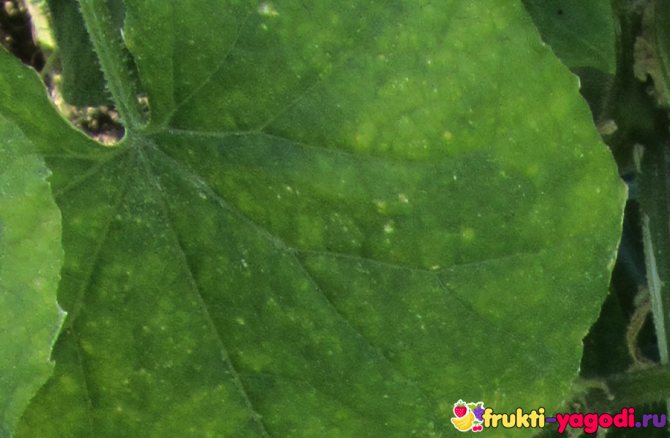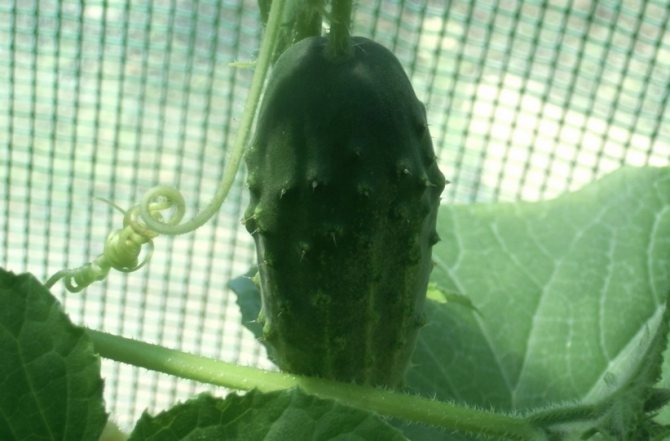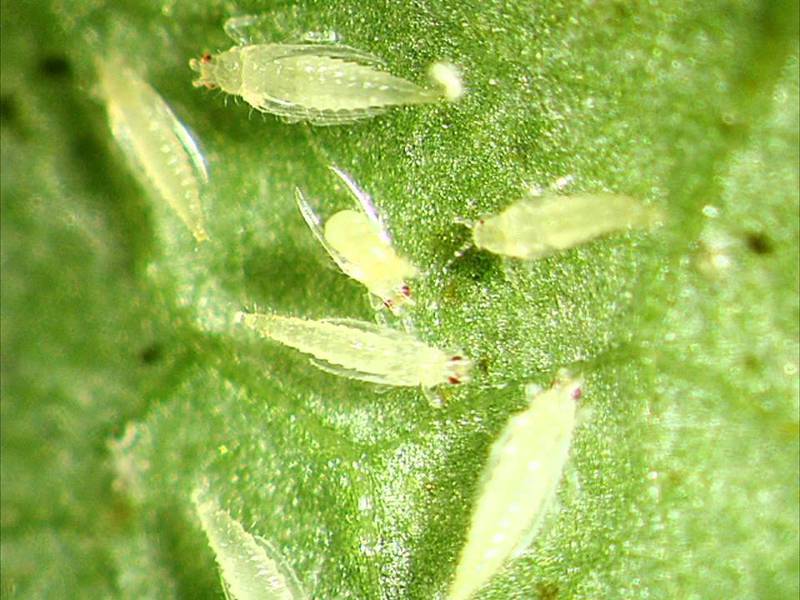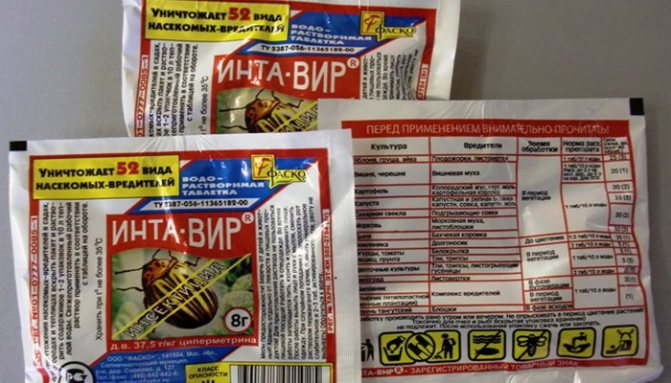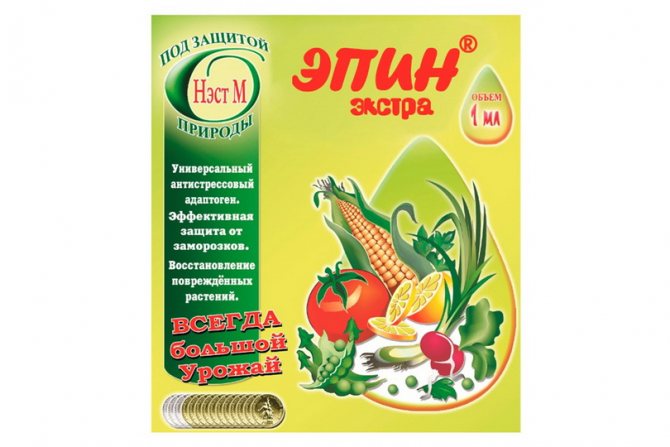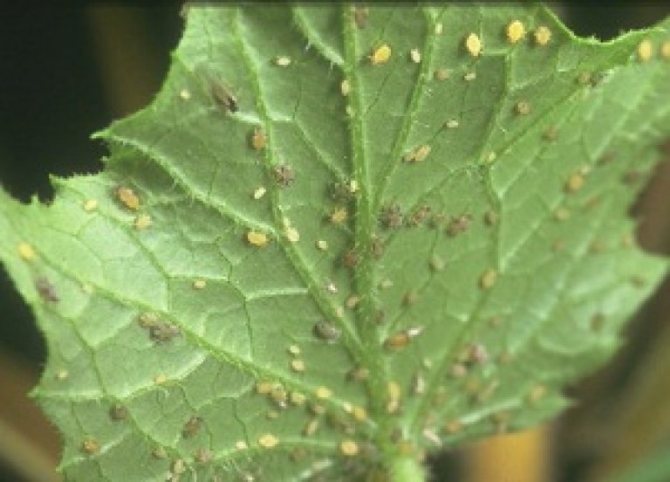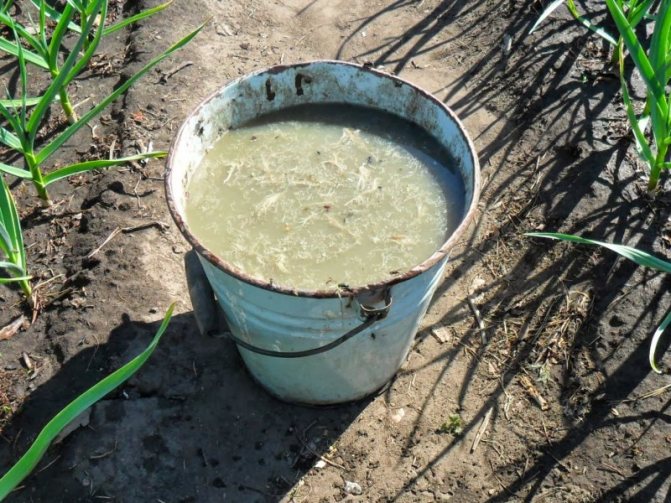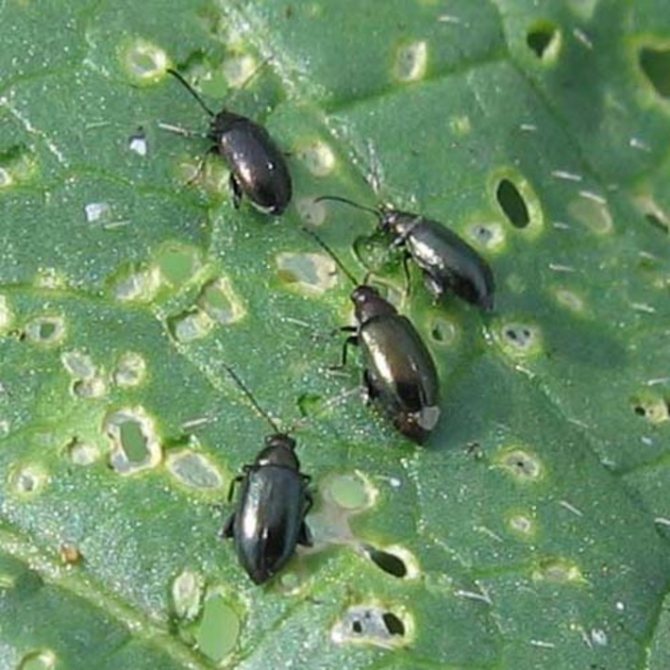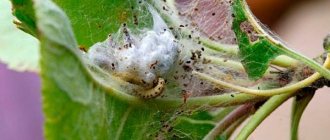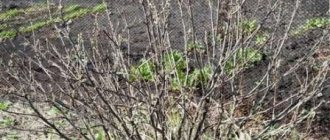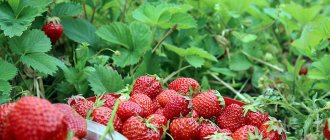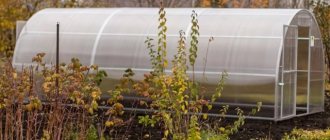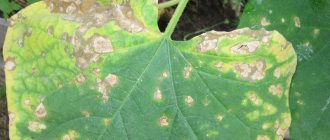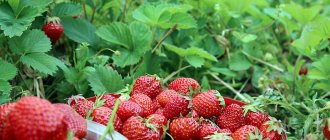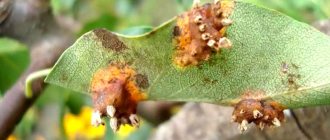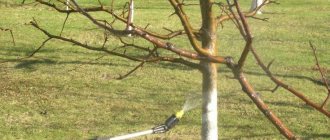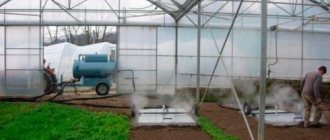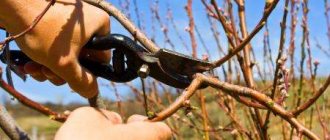Pests of cucumbers - description with photo
Table 1
| Name | Description |
Spider mite | This pest is ubiquitous, but gives more preference to enclosed spaces. The appearance of a tick is evidenced by a cobweb that was woven by an insect on growth shoots. A reddish-green small pest hides on the underside of the leaf plate During the season, the female is able to lay more than one and a half hundred eggs, giving birth to several generations. 2 weeks after laying, the larvae are able to completely dehydrate the plant by sucking its juices The insect does not have a protective layer on the body, which makes it easier to fight it with chemicals |
Melon aphid | The name of the insect is conditional - the pest is omnivorous. The burn barely reaches 2 mm and has a green oblong-rounded body. You can find a colony of aphids on the underside of the leaf, where they hide from the weather and their enemies. In favorable conditions, the uterus is capable of giving up to 2 dozen generations during the growing season. At the same time, the founder of the genus is wingless and is in one place, and the offspring is settled by winged individuals Aphids are a poisonous insect, so the plant can quickly die. In addition, the pest is a carrier of dangerous diseases. |
Whitefly | This smallish insect with a yellow body and mealy wings looks like a butterfly. The imago does not cause much harm to plants - microscopic larvae that suck on the lower side of the leaf are dangerous. It is not possible to immediately detect a small pest. Its presence can be guessed by the wilting foliage and the numerous holes on the plate. Whitefly is also dangerous because it attracts sooty fungus spores to the plant |
Sprout fly | This pest prefers seeds and young seedlings. The average size of a fly is 3 mm, a newborn insect barely reaches 1 mm. It is this "trifle" that is a dangerous enemy for garden crops The insect's life cycle takes place in the soil. Therefore, the larvae, having a mandible instead of a head, eat everything that is there (including cucumber seedlings) |
Gall nematode | The favorite place of the harmful worm is indoor ground. It is difficult to find an insect - the nematode settles in the roots of plants, forming galls on them. There are no signs of damage to the aerial part, but the plants lag behind in development and outwardly look oppressed To make sure that the pest is present, it is recommended to dig up one bush and carefully examine its roots. Having found growths, you will have to remove the rest of the plants, and disinfect the earth |
Tobacco thrips | Another small pest with wings barely reaches a millimeter in size. Outwardly, striped insects look like tadpoles, but they have legs, and thanks to them thrips move quickly Both larvae and adults do harm, not missing a single site on the plant. The immune system of insects is resistant to any external influences, so it is difficult to fight them |
Black flea | Outwardly, this small insect is somewhat similar to parasites that annoy animals. They move very quickly, jumping from one sheet to another. The flea is very dangerous to plants. Sucking juice and gnawing tissue, the insect is able to destroy cucumber seedlings in a couple of days |
Ants | These insects do not feed on cucumbers, but breaking through numerous passages in the ground, they gnaw out the roots of plants. Therefore, despite the benefits of ants (enrichment of the soil with humus and microelements, destruction of parasites), the colonies that have arisen in cucumber beds will have to be fought |
Medvedka | Summer residents especially disliked this "robber". Adults are large enough - at least 5 cm in length. They have short wings and powerful toothed legs, with which they actively dig numerous passages in the ground For one clutch, the female is able to lay about 400 eggs. In 3 weeks the whole garden will be filled with an army of omnivorous larvae. They are dangerous both for seeds and seedlings, and for a fruiting plant. |
Slugs | At first glance, harmless mollusks are real scourges of garden crops. In fact, it is a "combine" for eating greens. Slugs destroy plantations in the shortest possible time, quickly wielding their mouth float, consisting of 40 thousand teeth |
If you just poison the pests with poisonous drugs, after 2 years the insects will stop responding to these drugs. Therefore, the fight should be complex - in parallel, parasites are scared away with folk remedies, traps are used, and beneficial insects are attracted.
For these measures to be effective, the use of chemicals and “clean methods” must be varied not only every year, but also throughout the growing season.
Industrial drugs
The methods of treatment and prevention of pests and diseases for cucumbers are many and varied, it is important to apply them correctly. Among the drugs produced by the industry, there are antifungal - fungicides - and for insect control - insecticides and acaricides. These funds show their properties better when used without additives, but with mass invasion of plants by parasites and ailments, procedures with mixtures are allowed.
Among the fast-acting chemical preparations for fungi (both types of dew, white rot), farmers often prefer Bordeaux liquid and copper sulfate. However, aggressive solutions sometimes suppress the development of not only pathogens of ailments, but also the garden crops themselves.
When processing plants, Aktellik is effective against ticks, thrips and whiteflies, Aktara is effective against aphids. Means "Barguzin" will help remove wireworms from cucumbers, and metaldehyde granules - slugs.
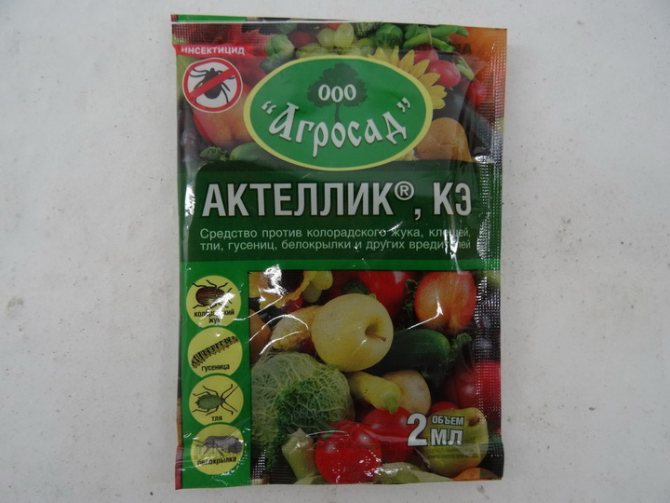
Consider the effect of other pesticides on diseased cucumbers:
- Hom. It is a modern counterpart to the popular Bordeaux liquid. Treatment with the drug destroys both types of powdery mildew, it can be used with fungicides and insecticides. It begins to act on cucumbers after 4 hours, the protective effect lasts 2 weeks. The use of the chemical does not develop disease resistance to its action.
- Ridomil Gold. A systemic insecticide is used to combat fungal diseases on plants (gray rot, peronosporosis). Its components quickly penetrate the tissues of cucumbers, destroying the cells of the pathogen. You can spray no more than 3 times during the season.
- Kvardris. A preparation similar to the one described above protects cultivated plants from diseases and is effective against spores. The maximum concentration of the active substance in cucumbers after the procedure is reached after 48 hours, it lasts for 14 days. Reuse is possible after 5 days.
- Fitosporin. A biological product based on a hay stick, which is suitable for treating plants from fungi. If applied at the first sign of the disease, it destroys root rot, olive spot and powdery mildew on cucumbers. A packet of powder must be diluted in 1 liter of warm water, left for 2 hours, then poured into a tank and add liquid to the volume of a bucket.
- "Spark". The insecticide kills over 60 species of insects.
In order for the pesticide to work faster, it is necessary to carry out pest control in cloudy weather.
From the bear, common preparations for cucumbers in the greenhouse and in the open field do not help.Farmers mix chemistry with odorous bait and scatter it over the beds. A living parasite can be destroyed by the following means:
- Medvetox;
- Boverin;
- Rembeck;
- Phenaxine plus.
How to get rid of pests - effective ways
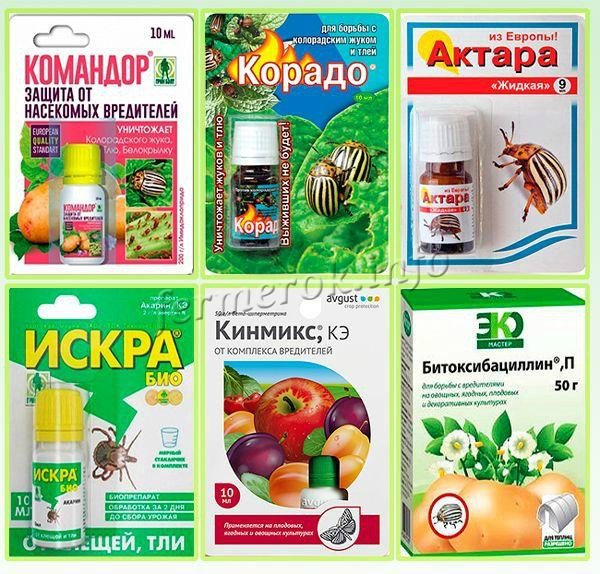

Each insect has its own taste preferences. In this regard, cucumbers were the least fortunate - there is a large list of pests that overcome this culture. The table below gives recommendations on how, taking into account the biological characteristics of insects, to effectively control them.
table 2
| Insect | Preparations * | Traditional methods |
| Spider mite | It is recommended to spray the beds with "Aktellikom", "Apollo", "Karbofos", "Neoron" | Infusions help well:
After insisting 5 days, dilute in a 1: 1 ratio and spray the plants ** |
| Melon aphid | "Aktofit", "Iskra", "Karbofos", "Commander" | The infusions of garlic and pepper described above are suitable. You can use a decoction of celandine - 400 g of leaves per 1 liter of water. First, they insist for a day, then boil over low heat for 30 minutes |
| Whitefly | Akarin, Aktara, Aktellik, Iskra, Confidor, Mospilan | In addition to onions and garlic, you can use tobacco - 50 g per 1 liter of boiling water. Insist in a dark place for 5 days, use strained A solution of laundry soap (in a ratio of 1: 6) helps well in the greenhouse. The composition is foamed and applied with a sponge to the leaves. |
| Sprout fly | Soil cultivation with Iskra helps | You need to fight this pest with preventive methods:
|
| Gall nematode | Affected plants and soil can be treated with "Phosphamide", "Ruskamin", "Mercaptophos". Spraying is carried out at least 4 times at regular intervals | With a weak damage to plants, their roots are dipped in hot water (50-55 degrees) and the bushes are transplanted to a new place. The old soil is destroyed, and the containers and racks in the greenhouse are disinfected |
| Tobacco thrips | Treatment of bushes with preparations "Ankara", "Iskra", "Commander Maxi", "Fufanon" | Strong infusions of onion husks, garlic, celandine help. Despite the love of thrips for planting tobacco, you can cope with pests with nicotine infusions It is worth taking other measures of influence:
It is recommended to run orius bugs eating thrips on the beds |
| Black flea | Among the chemicals are effective "Aktara", "Arrivo", "Decis", "DDT", "Sherpa" Of the biological products, Guapsin is recommended | The flea does not like dirty leaves, so you can fight the pest with street dust. Good pollination with a mixture of ash and tobacco Will scare away the insect and the film formed on the leaves with a solution of tar soap |
| Ants | "Thunder-2", "Anteater", "Muratsid", etc. | Effective baits made of sugar and boric acid, spread evenly over the area The soil can be sprinkled with lime, powdered with ash, ground pepper or mustard powder |
| Medvedka | The most effective means "Aktara", "Bazudin", "Boverin", "Thunder", "Medvetoks", "Nemabaktin", "Prestige" | Drive the bear out of the minks with a solution of laundry soap (2 pieces) with washing powder (1 tablespoon) on a bucket of water An insect can be lured by digging in a half-liter can with a small amount of beer in the garden You can distract the bear from the garden with dung heaps located outside the site |
| Slugs | In small beds, you can use calcium-containing dressings. Large plantations will have to be processed by "Thunderstorm", "Meta", "Slime-eater", "Ferramol" | Slugs, like bears, will not pass by the beer trap It is recommended to sprinkle garden plantations with ash - its slugs are bypassed Scared away insects and allspice, parsley, rosemary, cilantro, scattered on the beds in a chopped form |
*It is recommended to use chemical preparations in extreme cases and only on large plantations - cucumbers are capable of accumulating poisons. Therefore, this method of control is best used only in the early stages of plant development, before flowering.
**Spraying cucumbers should be carried out in the evening, at intervals of 3-5 days
Among the universal chemicals, Fitoverm can be distinguished. He easily copes with all types of pests that feed on cucumber bushes.
How do they get on cucumbers
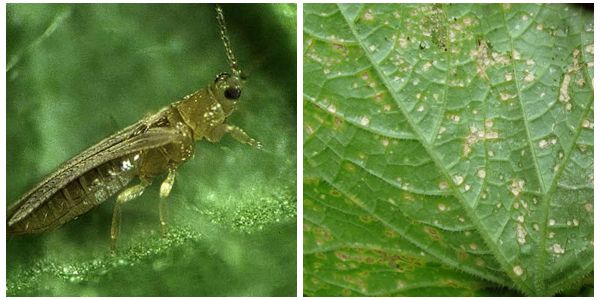

Most often, thrips on cucumbers can be found in greenhouse conditions. They get there with onion skins and, thanks to the warm microclimate, can grow several generations.
As soon as the air temperature drops below a comfortable one, they burrow into the upper layers of the soil or into small heaps of debris, husks, where they overwinter until the onset of heat.
Preventive measures
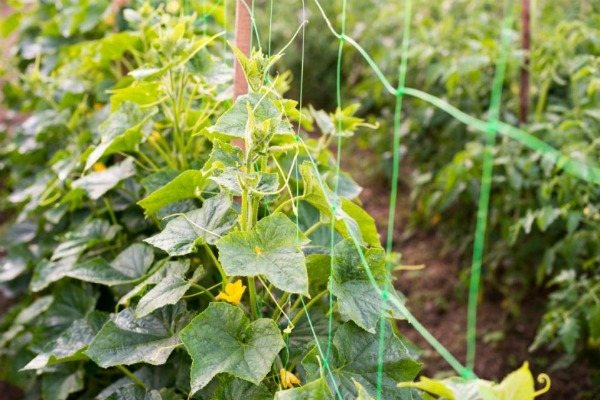

The fight against harmful insects in the beds will be more effective if measures are taken to prevent their invasion. Typical preventive actions include:
- the area set aside for the garden is recommended to be dug up from the fall to the full depth of the shovel with the overturning of the clod of earth; if there are insect clutches in the ground, they will be unprotected and will quickly freeze out;
- immediately before planting crops, it is recommended to spill the land in the beds with boiling water;
- cucumbers are best grown by seedlings; before planting seedlings in a permanent place, it is recommended to process them with "Parathion";
- during the care of cucumbers, weed control is mandatory; these plants attract most pests to the garden;
- loosening the soil allows you to destroy the clutches of insects in the ground;
- along the perimeter of the beds, you can plant a "living cordon" that repels pests - marigolds, marigolds, Persian chamomile, chicory, nasturtium. Essential oils exuded by spicy crops (basil, dill, parsley, coriander, parsnip, celery) have an insecticidal effect;
- the same plants, as well as the tops of potatoes, tomatoes, peppers, are used as mulch, solving 3 problems at once - they fertilize the earth, prevent moisture from evaporating and scare away insects;
- a good protection of the beds will be their cover with agrofibre - the greenhouse effect created under the film is destructive for many insects;
- if a bear starts up in the garden, it is lured by manure pits, where insects from all over the site will gather for the winter; closer to cold weather, fertilizer is scattered in a thin layer over the harvested beds; which will lead to the freezing of pests.
If the principles of crop rotation are used in the cultivation of garden crops, this will reduce the number of pests on the site. It is not recommended to plant linden, viburnum, petunia next to vegetable beds.
Why are thrips dangerous?
Thrips belong to one of the dangerous types of pests, because, due to their small size (the body of an adult insect is 1 - 2 mm), they may not be immediately detected on the plant. They lead a hidden way of existence, hiding in leaves and flowers, and in the meantime they suck the juice from the leaf plate of the plant, carry viruses and cause irreparable harm to the crop.
On cucumber leaves affected by thrips, small, barely noticeable white lines appear, then they increase, merge into dry spots. A hole forms on the sheet, which leads to its death. The plant begins to grow slowly, lose leaves and flowers, and bear fruit poorly.
What other problems are there?
In addition to numerous diseases and pests, cucumbers may not be born due to a fungal infection that infects the soil. It is possible to detect infection if the ground in the greenhouse is covered with a white bloom - in the form of mold. The solution to the problem in this case will be drugs: "Fundazol", "Hom", "Fitosporin". The preparations are added to the water during watering, after which the soil is loosened, leaving it to dry completely.
In conclusion, we note that it is possible to grow healthy vegetables, especially if these are rare medicinal orange cucumbers, but only if the recommendations for the care of the soil and plants with seasonal treatment and disease prevention are followed.
Care rules and preventive measures
There are a number of rules for caring for cucumber bushes in a greenhouse and open field. To prevent infection, the following types of measures are used:
- Disinfection with flame treatment.
- Cleansing the site from plant residues.
- Heat treatment of soil.
- Processing of windows and doors in a greenhouse.
- Pre-treatment of seeds before sowing.
- Whitewashing the greenhouse foundation.
- Regular inspection of plants and carrying out insecticidal spraying and watering.
Expert opinion
Stanislav Pavlovich
Gardener with 17 years of experience and our expert
Ask a Question
In a protected area, the soil should be changed every three years.

